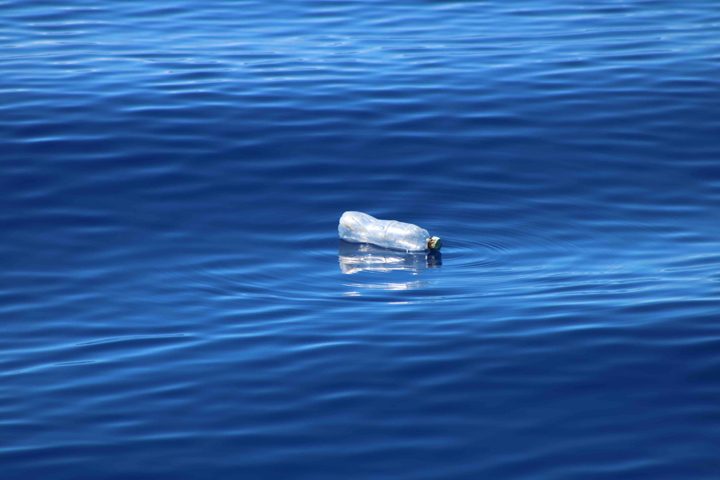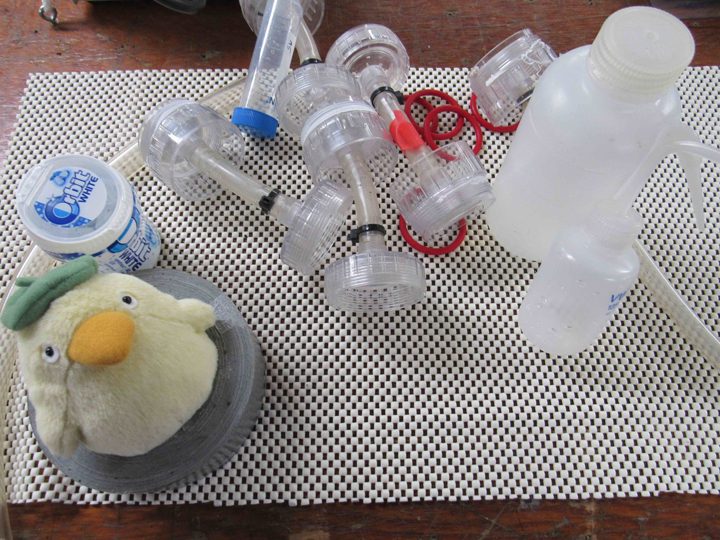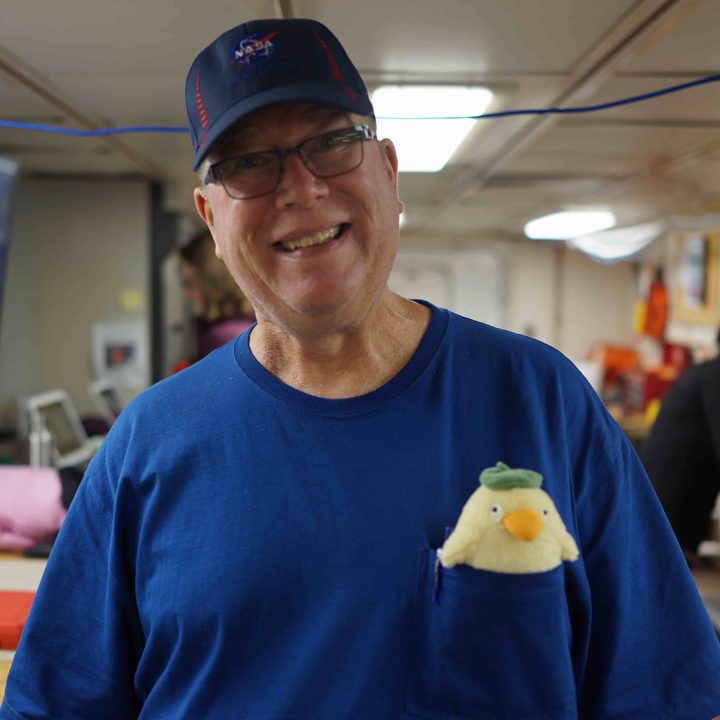Technology is a wonderful thing until its dark side is appreciated. I have written about plastic in prior blogs. I’ll probably have to write about plastic and the ocean for the rest of my life so more people are aware of the terrible toll that plastic has on marine life and the entire marine ecosystem.

A plastic bottle floating in the open ocean is not a rare scene.
Over the SPURS expeditions (Atlantic and Pacific Oceans) from 2012 to today we have seen much visible plastic in the open ocean. This month on Revelle, people have remarked on how little plastic we have seen. Likely that is just luck, because we know its out there.
As a relatively modern material technology, we humans see plastic, for the most part, as a critical and necessary element of our lives. It’s hard to imagine life without plastic, nor should we.

We have lots of plastic items on the Revelle.
We just need to pay more attention to the fate of all our plastic goods. Plastic is ubiquitous and its dark side is that it is a very long-lived substance. For plastic there is no corrosion, dissolving, or biodegrading (thankfully, perhaps, biodegradable plastic is now being invented!). The problem for the ocean is that about 8 million metric tons of plastic are estimated to enter the ocean each year. It is thrown away, washed away, blown away, and generally forgotten as it disappears into the ocean. It is illegal to dump non-biodegradable materials at sea and modern ships follow these international guidelines. The primary source of plastic in the ocean is not dumping at sea but plastic escaping from the land. We have the ways and means to control our plastic destiny if only we could control its disposal at the source!
Recent calculations project that by 2050 there be more plastic in the ocean than fish. Wherever you look, the facts about plastic in the ocean are alarming. The emerging science continues to raise new concerns. Are plastics changing the microbial ecosystem of the ocean? Is there any life form in the ocean that will not be impacted by plastic?
Much of the news one hears about plastic in the ocean relates to “garbage patches” near the center of all the ocean subtropical gyres. This is where surface circulation converges and floating material can accumulate. We can easily imagine what makes up these patches – it is the same material that washes up on islands and coasts worldwide – plastic bags, water bottles, fishing gear, styrofoam, and the detritus of modern life. One imagines the worst – growing islands of plastic debris – for example the well-known “Pacific Garbage Patch” between California and Hawaii. Sadly, there also “waves” of additional debris from tsunamis. Events in the Indian Ocean in 2004 and Japan in 2011 injected enormous amounts of coastal civilization into the ocean.
In reality some visible accumulations of large debris do occur, but they are difficult to find in the vast expanses of the ocean. It may be critical that we focus less on the cosmetic problem of visible garbage and focus more attention on the hidden problem of plastics. By hidden problem I mean this; if one tows a fine mesh net, you will find plastic almost everywhere in the ocean, today! In the ocean plastic is gradually broken into smaller and smaller pieces – eventually becoming what is known as microplastic (less than 5 mm in size). Microplastic becomes fully mixed with the microscopic plants (phytoplankton) and animals (zooplankton) that are the primary food source for ocean life-forms as diverse as sponges, anemones, small fish, and baleen whales. Life and death in the sea is becoming inextricably linked to plastics. Finding microplastics in sea life is the new normal.
The NASA Physical Oceanography Program assists in the study of plastic pollution of the ocean in a number of ways. With present satellite technology it is nearly, if not impossible, to detect from space plastic in the ocean. If dry and if large enough, plastic would have a sufficiently unique spectroscopic signature that remote sensing might be possible. However, most plastic and debris in the ocean is neither large nor dry, precluding direct detection. NASA Earth observation assets are mainly used to track the surface currents and wind responsible for the movement of marine debris. This data, along with sophisticated models of ocean circulation and debris characteristics, do account for the primary features of plastic and marine debris accumulation and distribution. Oceanography, in general, can predict where one might look for open ocean garbage patches (convergences), what accounts for significant differences in types of debris found on different coastlines (windage), and how fast debris disperses from a single source (general circulation dispersion statistics).
What science cannot explain (yet), among many things, is the mechanical and chemical degradation of plastic to microplastics, the fate of plastics and debris in the marine ecosystem, or fully identify the sources for all the plastics found in the ocean. Much research is yet to be done to understand the new ocean habitat known as the plastisphere.
As individuals we must raise awareness of plastic recycling and re-use. Proper disposal of plastics is critical for the health of the ocean.

Your blogger, Eric Lindstrom, with Ootori-sama.
Tags: ocean salinity, oceanography, SPURS, SPURS2




The picture of the ocean with one plastic bottle could be an award-winning photograph, in my opinion. It speaks 1,000 words and more. I hope you can enter it somewhere so a larger population could see it. It is amazing. And I’m not just talking about the “message.” The deep blue ocean, the ripples, all so perfect, and a deformed plastic bottle. Well, I’m not going to forget it soon. Thank you! KT McCann
Excellent article on plastic. Your clarification helps my awareness and become more conscientious about recycling. Even though Mobile, AL does not have a city-wide program there are centers where I can take it. I wonder if Ootori-sama is a replacement mascot from last year.
Katharine McCann,
Thanks so much for encouragement! Unfortunately I have many pictures of plastic bottles with the deep blue open ocean backdrop. I will take your suggestion and see if I can raise awareness through more wide-ranging exposure of the photo.
Regards
Eric
Dear MMJarrell,
Last year’s SPURS-2 mascot was “Monkey” – who is home with his young owner this year. We have Ootori-sama aboard thanks to David Ho from University of Hawaii. Ootori-sama may be overtaken in popularity by our two (very cute) Egrets who have adopted the ship. After a couple days aboard they have lost fear of us and walk around the deck like part of the science party.
Best
Eric
i love to go on space and see the world how it looks
Eric, do you have any graphs, calculations, or data tables showing how scientists extrapolated the amount of plastic in the ocean in the year 2050 compared to the amount of fish? Or is there a source you can suggest? I am a math teacher and I would love to show my students these so they can practice making their own extrapolations while learning about the gravity of this situation.
Thank you for your thought-provoking and interesting articles! The issue of plastic in the ocean is a serious and scary one.
Dear Dr. Lindstrom.
I am Alba Ragone, currently doing a PhD paper on Global plastics pollution and have seen this post: Plastic, Plastic, Where is All Our Plastic?
October 26 2017
And on one paragraph you commented this:
The NASA Physical Oceanography Program assists in the study of plastic pollution of the ocean in a number of ways. With present satellite technology it is nearly, if not impossible, to detect from space plastic in the ocean. If dry and if large enough, plastic would have a sufficiently unique spectroscopic signature that remote sensing might be possible.
I am looking forward to accessing satellite data on my research and I wonder if it is possible to get global imagery of plastics polluting-river-lines and oceans-coastal-zones.
I do appreciate there is plenty of data of localised-Global plastics-pollution observation and clearance, in coastlines, but this remains incomplete. And satellite data could help tackle Global-Oceanic plastics-pollution problem by mapping their Global entry routes.
In am also using your salinity, acidity and temperature data on this paper to ascertain impact on plastics degradation at sea; and I am also tackling legislation-constraints, including manufacturing, fishing industry, waste management and damping at sea.
I thank you for your time and great work of your team and all other teams at NASA earth Science.
Kind regards
Mrs. Alba Ragone